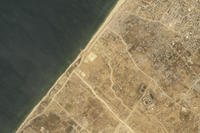On the same day the U.S. military dropped its most powerful non-nuclear bomb against Islamic State militants in Afghanistan, it released video of the Air Force testing so-called "mother of all bombs."
The video dates to 2003, when the service evaluated the 21,000-pounds GBU-34 Massive Ordnance Air Blast, or MOAB, at Eglin Air Force Base in Florida.
As my colleague Oriana Pawlyk reported over at Military.com, the bomb has the highest yield of any conventional ordnance in the U.S. stockpile. The biggest, however, is the GBU-57 Massive Ordnance Penetrator, or MOP.
To illustrate how big the GBU-43 conventional ordnance is, a Tomahawk cruise missile -- the type of munition recently launched from U.S. warships into Syria in response to a chemical attack -- weighs about 1,000 pounds.
%embed1%
The bomb, which is made by Dynetics Inc., releases from a weapon cradle in the MC-130 within seconds and relies on Global Positioning Satellites, or GPS, for guidance, according to an Air Force official who spoke to Military.com on background. It features controllable fins to accurately maneuver to within less than eight meters of the intended target, the official said.
Based in part on technology from Soviet-era intercontinental ballistic missiles, as previously reported by DefenseOne, the MOAB was tested at Eglin in 2003 but until Thursday has never been used in combat.
Defense experts welcomed the decision by the Trump administration to use the ordnance to attack ISIS militants in the eastern part of Afghanistan.
"It's quite appropriate, and in many ways about time, that this munition was employed," Thomas Donnelly, a resident fellow at the American Enterprise Institute, said in an email.
"The targets reported to have been struck -- dispersed personnel over a wide area and in tunnels -- are very difficult and expensive to hit with small munitions; these targets demand a weight of ordnance more than precision," he added. "Moreover, the narrow valleys of eastern Afghanistan have been redoubts of insurgents for centuries. The MOAB was made for operations like this, and perhaps the terrain even enhanced it effects."
Read our full story about the mission at Military.com.
-- Oriana Pawlyk and Hope Hodge Seck contributed to this report.









